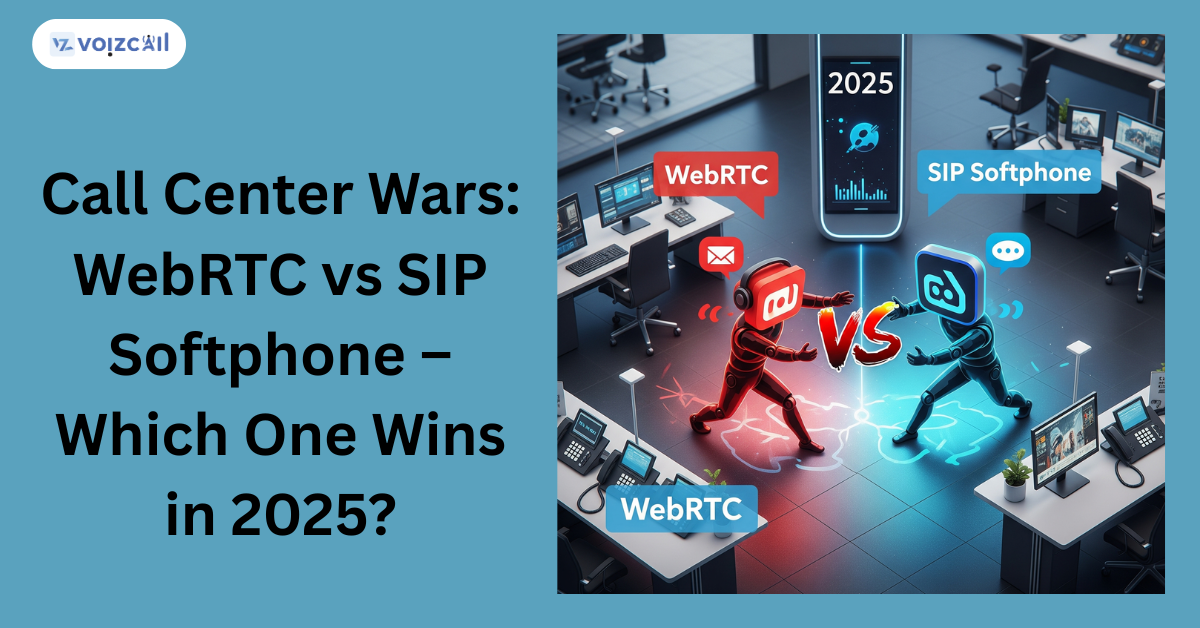


07/Jul/2025
Two technologies. One winner. The future of call centers depends on it.
Introduction: While fighting to take control of the call centers.
The modes and manner in which organizations conduct communications with customers are quickly changing as we move into 2025. The core of this change is two dominant technologies WebRTC and SIP softphones. Although they allow making calls through the internet, there are huge differences between the two in terms of infrastructure as well as the user experience and malleability.
Which then is more likely to enhance the workings of your call center in 2025? This blog has isolated the strengths, weaknesses and use cases of each of them so that you can know which side of the battle field to join.
A SIP softphone is the one based on software that allows communication through a VoIP phone. It links with a SIP server or even PBX system and by making use of either a laptop, desktop, or even mobile phone people can communicate.
Call forwarding and routing
Voicemail
Presence indicators
SIP trunking support
Multi-device compatibility
Pros of SIP Softphones:
Call / Email for Sales Inquiry Today
Proven, reliable VoIP protocol
Accommodates a broad level of gadgets and systems
Great for businesses with existing PBX setups
Cons:
Requires SIP server configuration
Often needs manual setup and maintenance
May face NAT/firewall issues without STUN/TURN
What is WebRTC?
WebRTC (Web Real-Time Communication) is an open-source product developed by Google and enables voice, video and data communication over the web via web browsers without downloading any software or operating any plugins.
Key Features:
Peer-to-peer calling
Support in native browser (Chrome, Firefox, Safari, Edge)
Built-in encryption
Seamless audio/video calling
Pros of WebRTC:
No downloads—runs in any modern browser
Ideal for remote and browser-based agents
Built-in encryption for secure calls
Fast to deploy and scale
Cons:
Not supported by older browsers
Still maturing in terms of stability
Needs integration of backend or gateway with WebRTC capabilities
WebRTC vs SIP Softphone: Comparative Ultimate
|
Feature |
SIP Softphone |
WebRTC |
|
Setup Complexity |
Moderate to High |
Low (browser-based) |
|
Call Quality |
High with stable network |
High, but browser-dependent |
|
Security Will be dependent on setup Display End to end encryption by default (needs SRTP/TLS) |
Flexibility of the Device Multi-device (needs app) Browser-based (any device) |
|
|
Security Will be dependent on setup Display End to end encryption by default (needs SRTP/TLS) |
Flexibility of the Device Multi-device (needs app) Browser-based (any device) |
|
|
Integration with CRM |
Possible via SIP APIs |
Easy with modern web apps |
|
Remote Agent Friendly |
Medium |
Excellent |
|
Cost of Deployment |
May involve licensing/server costs |
Cost-effective (no app needed) |
|
Scalability |
Requires more setup to scale |
Instantly scalable via web platform |
How to Select: What Is the Best One?
Go with WebRTC if:
You have a remote or hybrid team
You want to avoid downloading and maintaining softphone apps
Your need is to have an easy installation, access to any browser, and fast deployment
You need and a scalable product with in-built encryption
Stick with SIP Softphone if:
You already use a SIP-based PBX or VoIP system
You need advanced call routing and SIP trunking
Your IT team is equipped to manage SIP infrastructure
You need a time-tested VoIP solution
Real-World Scenarios
Case 1: A Startup Call Center
Switching to WebRTC allowed them to onboard remote agents instantly with just a browser login, reducing setup time by 70%.
They have an existing PBX system that prefers SIP softphones to deal with complex call flows and connectivity with desk telephones.
Bonus: Is it possible to Mix SIP and WebRTC?
Absolutely! Most of the current platforms are connecting SIP to WebRTC, so now you can have the flexibility of WebRTC and the stability of SIP. The hybrid strategy is particularly helpful in those situations where businesses desire a more gradual shift or those that have the need to accommodate on-site and remote agents.
Final thoughts: Who Is the Winner?
In 2025, it is WebRTC that is winning the hearts with its ease of use, browser support, and scalability, in particular, when it comes to modern, remote-first call centers.
However, it does not mean that SIP softphones become obsolete. They are a good option with high control, features and integration of legacy PBX.
Your decision should be informed by your current infrastructure of the call center, team distribution and the long term strategies.